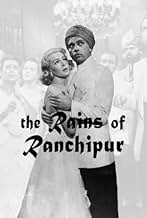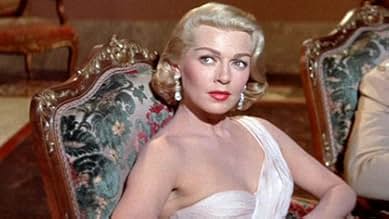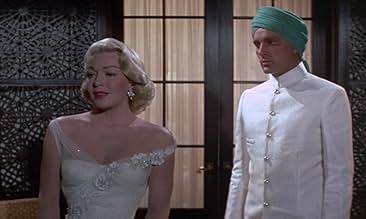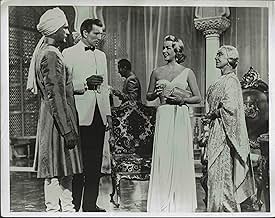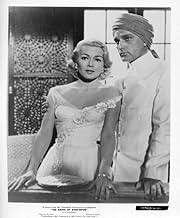IMDb RATING
5.8/10
1.2K
YOUR RATING
Despite marital problems, English Lord Albert Esketh and his rich American socialite wife Lady Edwina Esketh travel to India to buy a prize horse from the ruler of Ranchipur.Despite marital problems, English Lord Albert Esketh and his rich American socialite wife Lady Edwina Esketh travel to India to buy a prize horse from the ruler of Ranchipur.Despite marital problems, English Lord Albert Esketh and his rich American socialite wife Lady Edwina Esketh travel to India to buy a prize horse from the ruler of Ranchipur.
- Director
- Writers
- Stars
- Nominated for 1 Oscar
- 1 nomination total
Rama Bai
- Lachmaania
- (uncredited)
John Banner
- Rashid Ali Khan
- (uncredited)
Jugat Bhatia
- Headhunter
- (uncredited)
George Brand
- Mr. Simon
- (uncredited)
Argentina Brunetti
- Mrs. Adoani
- (uncredited)
King Calder
- Mr. Smiley
- (uncredited)
Jack Deery
- Party Guest
- (uncredited)
Paul Frees
- Sundar
- (uncredited)
- Director
- Writers
- All cast & crew
- Production, box office & more at IMDbPro
Featured reviews
This glamorous remake of the '30s film "And The Rains Came", casts Lana Turner, Richard Burton, and Fred McMurray. Turner is a woman who travels with her husband to India to purchase some horses. While there, the unsatisfied Lana embarks on an affair with Hindu doctor Burton, breaking taboos and causing a ruckus among the elite set. All the drama is compounded by a series of earthquakes and one big flood that threatens the lives of everyone. It's hard to tell what's more beautiful to look at - the Indian scenery(really filmed in Pakistan) or the always elegant Lana. Storyline-wise there's not a lot of substance, but it's truly a visual feast regardless.
A quaint film. shot in Pakistan about events in India. Ranchipur is a fictional kingdom of undivided India, Richard Burton plays a brown skinned South Asian. He does a fairly good job except when he speaks Urdu/Hindi to the native patients and servants.
The main actors played the roles in Hollywood not in Pakistan. The earthquake and street scenes are very realistic for a 1955 film. It certainly deserved the Special Effects Oscar nomination it bagged.. There was an earlier 1930 version of the film scripted by Philip Dunne, where the Lana Turner character dies. That decision to remove the death from the script of the later Negulesco version definitely weakened it as it reiterates the Lana Turner character Edwina as woman who had affairs and dropped them in due course. Had that change not been made the film would have been remarkable. Even the cobra in the film is a real one, not a prop.
As an Indian, I admired the performance of Eugenie Leontovich as the Maharani as she spoke like an Indian maharani would despite her awful wig.
This is one of the rare films of the Fifties showing inter-racial relationships.
The main actors played the roles in Hollywood not in Pakistan. The earthquake and street scenes are very realistic for a 1955 film. It certainly deserved the Special Effects Oscar nomination it bagged.. There was an earlier 1930 version of the film scripted by Philip Dunne, where the Lana Turner character dies. That decision to remove the death from the script of the later Negulesco version definitely weakened it as it reiterates the Lana Turner character Edwina as woman who had affairs and dropped them in due course. Had that change not been made the film would have been remarkable. Even the cobra in the film is a real one, not a prop.
As an Indian, I admired the performance of Eugenie Leontovich as the Maharani as she spoke like an Indian maharani would despite her awful wig.
This is one of the rare films of the Fifties showing inter-racial relationships.
Lord Esketh, a British aristocrat, and his glamorous American wife, Edwina, are touring India and staying in the city of Ranchipur, where they are guests of the local Maharani. (The action is supposed to be set in India, even though we see a prominently displayed Pakistani flag in an early scene). Their marriage is an unhappy one and each despises the other. Edwina despises her husband because she sees him as weak and cowardly and because he only married her for her money. (She is an independently wealthy heiress). He despises her because he sees her as cold and heartless; we learn that she has been unfaithful to him with a number of different men. While in Ranchipur Edwina meets and has an affair with a young suntanned Welshman in a turban.
Well, actually Richard Burton's character is supposed to be an Indian, Dr Safti, a physician and the adopted son of the Maharani. Today, the idea of a white actor in "brownface" playing an Indian would strike most people as politically incorrect, but was an accepted practice in the fifties, and at least Burton's performance is a lot less insensitive than that given by Peter Sellers in "The Millionairess" from a few years later. (Sellers was also playing an Indian doctor). Watching the film, I wondered if the use of the Christian name "Edwina" was a veiled reference to Edwina Mountbatten, another independently wealthy heiress, married to a British aristocrat, who visited India and was rumoured to have had an affair with an Indian man, in her case the politician Jawaharlal Nehru. I understand, however, that "The Rains of Ranchipur" is a remake of "The Rains Came" from 1939 (which I have never seen), and that the character had the same name both in this film and in the 1937 novel on which it was based. As the Mountbattens did not come to India until 1947, the coincidence was presumably unintentional.
The Edwina-Safti romance is the mainspring of the plot, but for all Edwina's good looks she is so obviously spoilt, selfish and promiscuous that it is difficult to imagine any man, let alone one as intelligent and idealistic as Dr Safti, falling hopelessly in love with her. There is a subplot involving another romance between Tom Ransome, an alcoholic former lover of Edwina and close friend of Safti, and Fern, the daughter of a local missionary, but this arouses little interest.
The acting is generally undistinguished. Burton, as though embarrassed by having been cast in a role to which he was ill-suited, is horribly stilted and wooden, giving by far his worst performance in any film of his which I have seen. The Russian-born Eugenie Leontovich as the Maharani is no more convincing as an Indian than is Burton. Lana Turner as Edwina and Fred MacMurray as Tom were both capable of much better things than this. Probably the best is Joan Caulfield as Fern. The intention seems to have been to contrast Fern's youth and innocence with the cynicism and corruption of the experienced older woman Edwina, so it is perhaps surprising that Caulfield, who at 33 was only a year younger than Turner, was cast in the role, but she is fresh and youthful-looking enough to succeed in making the contrast an effective one.
The best thing about the film is its special effects. Although "The Rains of Ranchipur" is not a "disaster movie" in the sense that the film-makers of the seventies would have understood the term, an earthquake and the subsequent flood after the earthquake destroys a dam play important roles in the story. These scenes are very well done, are still convincingly impressive even in the era of CGI and the main reason why I have given the film an average mark. Unfortunately, there is little else to make the film worth watching today. Special effects apart, it is the sort of dull, turgid and implausible melodrama which typified Hollywood at its worst during the fifties. 5/10
Well, actually Richard Burton's character is supposed to be an Indian, Dr Safti, a physician and the adopted son of the Maharani. Today, the idea of a white actor in "brownface" playing an Indian would strike most people as politically incorrect, but was an accepted practice in the fifties, and at least Burton's performance is a lot less insensitive than that given by Peter Sellers in "The Millionairess" from a few years later. (Sellers was also playing an Indian doctor). Watching the film, I wondered if the use of the Christian name "Edwina" was a veiled reference to Edwina Mountbatten, another independently wealthy heiress, married to a British aristocrat, who visited India and was rumoured to have had an affair with an Indian man, in her case the politician Jawaharlal Nehru. I understand, however, that "The Rains of Ranchipur" is a remake of "The Rains Came" from 1939 (which I have never seen), and that the character had the same name both in this film and in the 1937 novel on which it was based. As the Mountbattens did not come to India until 1947, the coincidence was presumably unintentional.
The Edwina-Safti romance is the mainspring of the plot, but for all Edwina's good looks she is so obviously spoilt, selfish and promiscuous that it is difficult to imagine any man, let alone one as intelligent and idealistic as Dr Safti, falling hopelessly in love with her. There is a subplot involving another romance between Tom Ransome, an alcoholic former lover of Edwina and close friend of Safti, and Fern, the daughter of a local missionary, but this arouses little interest.
The acting is generally undistinguished. Burton, as though embarrassed by having been cast in a role to which he was ill-suited, is horribly stilted and wooden, giving by far his worst performance in any film of his which I have seen. The Russian-born Eugenie Leontovich as the Maharani is no more convincing as an Indian than is Burton. Lana Turner as Edwina and Fred MacMurray as Tom were both capable of much better things than this. Probably the best is Joan Caulfield as Fern. The intention seems to have been to contrast Fern's youth and innocence with the cynicism and corruption of the experienced older woman Edwina, so it is perhaps surprising that Caulfield, who at 33 was only a year younger than Turner, was cast in the role, but she is fresh and youthful-looking enough to succeed in making the contrast an effective one.
The best thing about the film is its special effects. Although "The Rains of Ranchipur" is not a "disaster movie" in the sense that the film-makers of the seventies would have understood the term, an earthquake and the subsequent flood after the earthquake destroys a dam play important roles in the story. These scenes are very well done, are still convincingly impressive even in the era of CGI and the main reason why I have given the film an average mark. Unfortunately, there is little else to make the film worth watching today. Special effects apart, it is the sort of dull, turgid and implausible melodrama which typified Hollywood at its worst during the fifties. 5/10
For those among us who grew up watching a lot of television in the 1960s,it's always a lot of fun seeing stars doing supporting roles earlier in their careers.And who's doing the bluff,hearty,amiable Sikh police captain?None other than John Banner,who went on to do the comic heavy Schultz,on"Hogan's Heroes."And,for all of his teutonic ponderousness,he does manage to carry it off.
I was halfway through this movie before realizing I'd seen it before. Only, I remembered it filmed in black and white, with Myrna Loy as the star, instead of Lana Turner in Technicolor. The Rains of Ranchipur is a remake of the 1939 disaster drama The Rains Came. In both movies, a married hussy seduces an Indian doctor while living in Ranchipur. Her attentions become a blot on his impeccable reputation, and she has nothing more than her own interests at heart.
At first, I thought the remake would be an improvement. Myrna Loy was never known for her seductive prowess, but that type of behavior was second nature to Lana Turner, so I thought the steamy scenes would be steamier. Also, Tyrone Power played the Indian doctor in the original, rather than an ethnically appropriate actor, so I hoped the remake would make a better casting choice. No and no. Even though Myrna isn't the sexiest actress out there, her chemistry with Tyrone was infinitely more sizzling than Lana's was with Richard Burton. Wait, Richard Burton played the Indian doctor? I'm sorry to have to tell you that yes, he did, and with nothing more than a plain turban wrapped around his head as indication that he's racially different than his love interest. The two stars, who are very capable of creating sexual tension on the screen, must have hated each other during the filming. The chemistry was nonexistent.
I'll try not to spoil anything, but this plot point is in the title: a monsoon rains down on Ranchipur. Believe it or not, the big disaster scene is scarier, more effective, and had better special effects in 1939 than in 1955! The costumes were also quite elegant and regal in the original version. Myrna was dressed in beautiful ball gowns, and Tyrone had resplendent outfits. Richard Burton was very plainly clad, and Lana Turner's dresses actually made her look like she had a bad figure.
All in all, the remake was a big disappointment. Watch The Rains Came instead. It's dramatic, sexy, and exciting—I don't know how the monsoon scene was filmed in 1939!
At first, I thought the remake would be an improvement. Myrna Loy was never known for her seductive prowess, but that type of behavior was second nature to Lana Turner, so I thought the steamy scenes would be steamier. Also, Tyrone Power played the Indian doctor in the original, rather than an ethnically appropriate actor, so I hoped the remake would make a better casting choice. No and no. Even though Myrna isn't the sexiest actress out there, her chemistry with Tyrone was infinitely more sizzling than Lana's was with Richard Burton. Wait, Richard Burton played the Indian doctor? I'm sorry to have to tell you that yes, he did, and with nothing more than a plain turban wrapped around his head as indication that he's racially different than his love interest. The two stars, who are very capable of creating sexual tension on the screen, must have hated each other during the filming. The chemistry was nonexistent.
I'll try not to spoil anything, but this plot point is in the title: a monsoon rains down on Ranchipur. Believe it or not, the big disaster scene is scarier, more effective, and had better special effects in 1939 than in 1955! The costumes were also quite elegant and regal in the original version. Myrna was dressed in beautiful ball gowns, and Tyrone had resplendent outfits. Richard Burton was very plainly clad, and Lana Turner's dresses actually made her look like she had a bad figure.
All in all, the remake was a big disappointment. Watch The Rains Came instead. It's dramatic, sexy, and exciting—I don't know how the monsoon scene was filmed in 1939!
Did you know
- TriviaLa mousson (1955) was originally to be shot on location in both India and Pakistan. Modern sources claim that India refused to grant the studio a filming permit, however, and contemporary sources reported that backgrounds for the picture were shot on location in Pakistan only. Some location shooting was also done on the Twentieth Century-Fox ranch in Malibu, CA. Principal players never left Hollywood. Doubles filled in for the main cast in the long shots and whatever other scenes that were needed.
- ConnectionsEdited into Notre homme Flint (1966)
- How long is The Rains of Ranchipur?Powered by Alexa
Details
- Release date
- Country of origin
- Language
- Also known as
- The Rains of Ranchipur
- Filming locations
- Production company
- See more company credits at IMDbPro
Box office
- Budget
- $4,500,000 (estimated)
- Runtime1 hour 44 minutes
- Aspect ratio
- 2.55 : 1
Contribute to this page
Suggest an edit or add missing content


